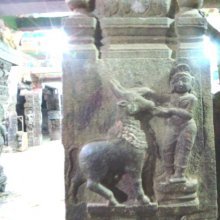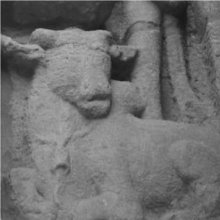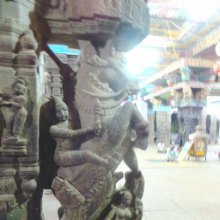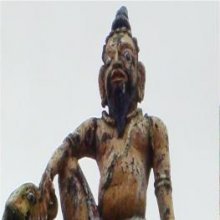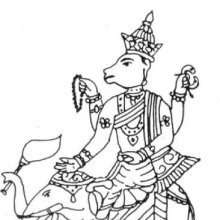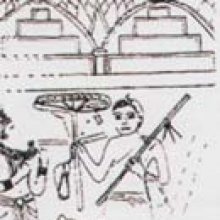Bull: 2 definitions
Introduction:
Bull means something in Hinduism, Sanskrit, the history of ancient India. If you want to know the exact meaning, history, etymology or English translation of this term then check out the descriptions on this page. Add your comment or reference to a book if you want to contribute to this summary article.
Images (photo gallery)
(+23 more images available)
In Hinduism
Shilpashastra (iconography)
Source: Shodhganga: Elements of Art and Architecture in the Trtiyakhanda of the Visnudharmottarapurana (shilpa)The Bull in iconography is associated with various deities, according to the Viṣṇudharmottarapurāṇa, an ancient Sanskrit text which (being encyclopedic in nature) deals with a variety of cultural topics such as arts, architecture, music, grammar and astronomy.—In the Viṣṇudharmottarapurāṇa, the attire, accessories, weapons, carrier, different colours etc. of the idols of different deities are projected which are taken for discussion here. It is clear that the book offers a great field of knowledge regarding the nuances of Indian art of Image making [e.g., the bull] during 10th–11th century A.D.
The Bull of Mahādeva.—According to the Viṣṇudharmottarapurāṇa, the image of Mahādeva should be placed on a statue of bull. But according to the Bṛhatsaṃhitā, the picture of bull should be placed on the flag of the image of Mahādeva
The Bull of Nāsatya (i.e., the twin god Aśvins).—According to the Skandapurāṇa Nāsatyas or the twin god Aśvins are the excellent physicians. In the Ṛgveda, the chariot of the Aśvins are said to be associated with a bull and a crocodile.

Shilpashastra (शिल्पशास्त्र, śilpaśāstra) represents the ancient Indian science (shastra) of creative arts (shilpa) such as sculpture, iconography and painting. Closely related to Vastushastra (architecture), they often share the same literature.
India history and geography
Source: Singhi Jain Series: Ratnaprabha-suri’s Kuvalayamala-katha (history)Bulls were commonly depicted on the Saṃsāracakra paintings (representing scenes of animal life), in ancient India, as mentioned in the Kathās (narrative poems) such as Uddyotanasūri in his 8th-century Kuvalayamālā (a Prakrit Campū, similar to Kāvya poetry).—Page 185.21 f.: Here follows a description of a printed scroll illustrating the Jaina conception of saṃsāracakra. [...] The saṃsāra-cakra illustrated the three worlds of hell, human world and the world of gods. [For example:] Fight between a tiger and a wild bull, and killing of a tiger with bull horns.

The history of India traces the identification of countries, villages, towns and other regions of India, as well as mythology, zoology, royal dynasties, rulers, tribes, local festivities and traditions and regional languages. Ancient India enjoyed religious freedom and encourages the path of Dharma, a concept common to Buddhism, Hinduism, and Jainism.
See also (Relevant definitions)
Starts with (+15): Bull silky oak, Bull skin, Bull thistle, Bull-nettle, Bull-oak, Bulla, Bullaga-kara, Bullaisu, Bullakaaya, Bullakaya, Bullani, Bullavane, Bullavisu, Bullayisu, Bullaysu, Bulle barke, Bulle bete, Bulle parale, Bulleparale, Bullet grass.
Ends with: Black bull, Bull skin, Wild bull.
Full-text (+2029): Vrishabha, Vrishotsarga, Govrisha, Shanda, Vrisha, Utsrishtapashu, Rishabha, Pungava, Bailapada, Balivarda, Gopati, Nandi, Goraja, Mahoksha, Usra, Shakvara, Gava, Vriddhoksha, Gonatha, Ukshatara.
Relevant text
Search found 256 books and stories containing Bull; (plurals include: Bulls). You can also click to the full overview containing English textual excerpts. Below are direct links for the most relevant articles:
Harivamsha Purana (by Manmatha Nath Dutt)
Chapter 21 - Death of Aristha < [Book 2 - Vishnu Parva]
Chapter 88 - Andmaka Goes to the Mount Mandara < [Book 2 - Vishnu Parva]
Chapter 19 - Indra Comes and Eulogises Krishna < [Book 2 - Vishnu Parva]
Manusmriti with the Commentary of Medhatithi (by Ganganatha Jha)
Verse 8.242 < [Section XXXIX - Disputes between Owner and Keeper]
Verse 9.122-123 < [Section XVI - Detailed Laws of Partition among Sons]
Verse 9.124 < [Section XVI - Detailed Laws of Partition among Sons]
The Religion and Philosophy of Tevaram (Thevaram) (by M. A. Dorai Rangaswamy)
Chapter 1.4 - Rishabharudha-murti (depiction of the Brahmani bull) < [Volume 2 - Nampi Arurar and Mythology]
Symbology of khatvanga in the Mahavrata < [Volume 2 - Nampi Arurar and Mythology]
Nayanar 45: Kalia (Kaliya) < [Volume 4.1.1 - A comparative study of the Shaivite saints the Thiruthondathogai]
Vinaya Pitaka (3): Khandhaka (by I. B. Horner)
Rejection of vehicles, etc. < [5. Leather (Camma)]
On going to Pārileyyaka < [10. The monks from Kosambī (Kosambaka)]
Allowance for the first seat, etc. < [16. Lodgings (Sayanāsana)]
Amarakoshodghatana of Kshirasvamin (study) (by A. Yamuna Devi)
Fauna (5): Domesticated animals (c): Large bull < [Chapter 5 - Aspects of Nature]
Music (Nāṭya-varga) < [Chapter 4 - Cultural Aspects]
Village Folk-tales of Ceylon (Sri Lanka), vol. 1-3 (by Henry Parker)
Story 14 - The Four Deaf Persons < [Part I - Stories told by the Cultivating Caste and Vaeddas]
Story 40 - A Kadambawa Man's Journey To Puttalam < [Part II (b) - Stories of the Tom-tom Beaters]
Story 53 - The Pots Of Oil < [Part II (b) - Stories of the Tom-tom Beaters]
Related products
